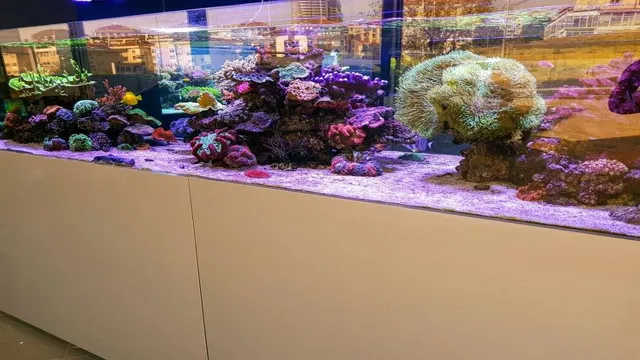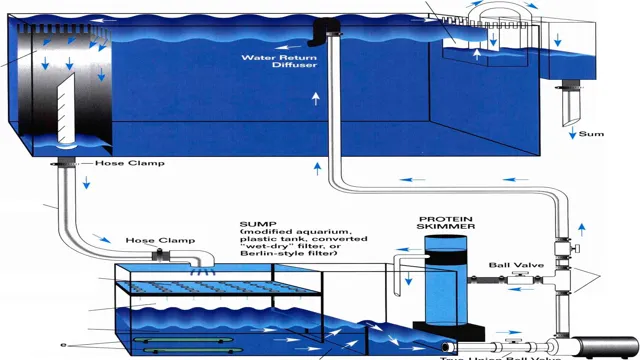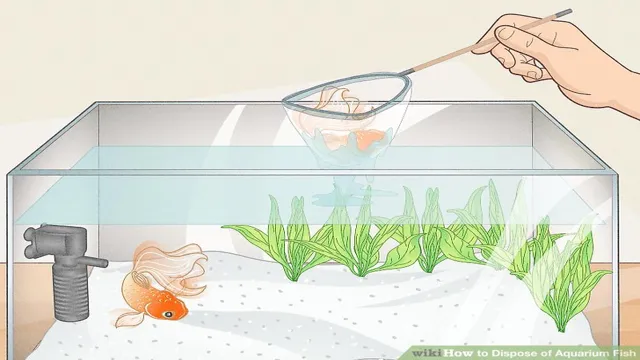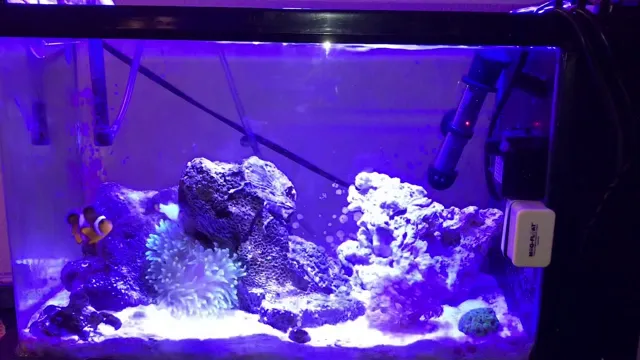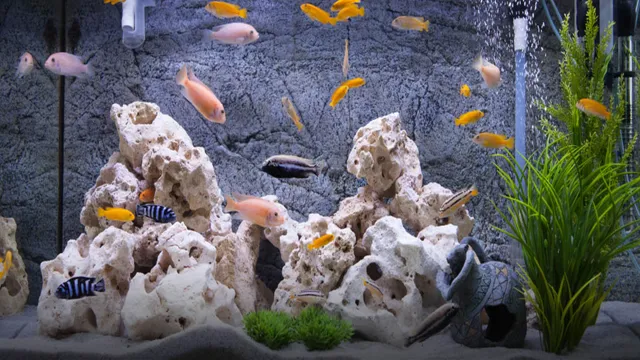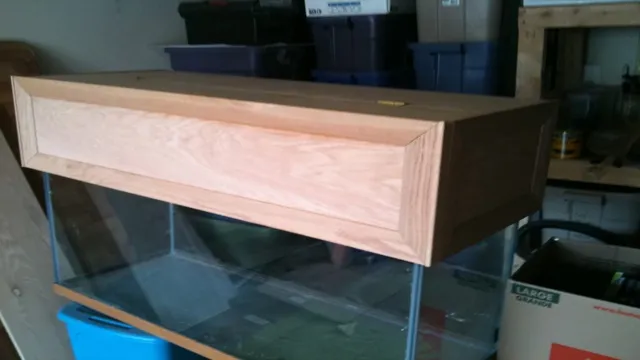Have you ever wondered how thick a saltwater aquarium can be? Well, the answer may surprise you! It’s not as straightforward as a simple measurement or set limit. The thickness of a saltwater aquarium depends on several factors, such as the type of glass or acrylic used, the aquarium’s size, and the water pressure it can sustain. To simplify it, the thickness of an aquarium glass or acrylic should be enough to withstand the water pressure exerted without breaking or bowing.
So, how do you determine the right thickness? With the use of specialized software, you can calculate the required thickness based on the aquarium’s dimensions and the type of material used. It’s important to note that a thicker aquarium is not always better. Thinner aquariums may look more aesthetically pleasing, depending on your preference.
However, a thicker specimen can offer better insulation for your fish and plants and distribute pressure more evenly. Ultimately, the thickness of your saltwater aquarium is a crucial factor in the safety and longevity of your aquatic creatures. Therefore, it’s essential to consult with professionals to determine the right thickness for your specific needs and preferences.
Understanding the Importance of Thickness
As a saltwater aquarium enthusiast, understanding the importance of thickness is crucial. The thickness of a saltwater aquarium refers to the thickness of the glass or acrylic used to construct the tank. A thicker tank will be stronger, more durable, and less likely to break or crack under pressure.
The thickness also affects the appearance of the tank, as thicker glass or acrylic will distort the view less than thinner materials. When choosing the thickness of your saltwater aquarium, it is important to consider the size and weight of the tank, as well as the type and quantity of marine life that will be housed inside. It is recommended to opt for thicker, higher quality materials to ensure the safety and longevity of your aquarium.
So, how thick is a saltwater aquarium? There is no one-size-fits-all answer, as it depends on the specific tank and its inhabitants. It is best to consult with a professional to determine the ideal thickness for your saltwater aquarium.
Preventing Cracks and Leaks
When it comes to preventing cracks and leaks in any construction project, understanding the importance of thickness is crucial. Having the right thickness of material is essential to ensure that structural integrity is maintained over time. Whether it’s concrete, roofing materials, or waterproof membranes, a thicker material will be more resistant to potential damage and degradation.
A thinner material, on the other hand, may save money in the short term, but can ultimately result in costly repairs down the line. Think of it like the soles of a sturdy hiking boot versus a flimsy flip flop – the thicker sole offers more support and durability against wear and tear. So, when planning any construction project, consider the thickness of materials carefully to ensure long-term success and avoid unnecessary headaches in the future.

Factors That Affect Aquarium Thickness
If you’re wondering how thick a saltwater aquarium should be, there are a variety of factors that can affect the final answer. For instance, the size and shape of the aquarium, as well as the type and number of the fish and other creatures living inside, can all impact the required thickness of the glass. Additionally, the height of the water column and any pressure changes that might occur due to temperature fluctuations or water movement can also influence the necessary thickness of the aquarium walls.
Ultimately, it’s essential to consult with an aquarium expert or professional glassmaker to determine the optimal thickness for your specific setup and ensure the safety and well-being of your aquatic pets. Remember, when it comes to aquarium glass, it’s always better to err on the side of caution and invest in quality materials rather than taking shortcuts that could put your fish at risk. (See Also: How to Make a Sliding Glass Top for Aquarium – DIY Guide for a Clean and Safe Environment)
Type of Glass or Acrylic
The type of material used in an aquarium’s construction is a crucial factor in determining its thickness and therefore, its durability. Two main materials are available – glass and acrylic. Glass is an excellent choice for aquariums because of its strength, transparency, and scratch-resistant surface.
However, the thickness required to ensure the aquarium’s structural integrity depends on its height and water depth. Acrylic, on the other hand, offers greater flexibility because it is lighter and can be molded into different shapes. However, it can scratch more easily than glass and is more susceptible to discoloration or yellowing over time.
Therefore, when choosing the type of material to use, it is essential to consider factors such as cost, visibility, and durability requirements. Ultimately, the choice between glass and acrylic will depend on each aquarist’s personal preference and needs.
Aquarium Size and Shape
When choosing the size and shape of your aquarium, there are several factors to consider that can affect the thickness of the glass or acrylic. One such factor is the water volume it will hold. As the water volume increases, so does the weight of the aquarium.
Therefore, thicker glass or acrylic is needed to support the weight of the water and prevent the aquarium from cracking or breaking. Another factor to consider is the shape of the aquarium. A tall, narrow tank will require thicker glass or acrylic to support the weight of the water, as the pressure on the bottom of the tank increases as the height of the water column increases.
On the other hand, a wide, shallow tank will require less thickness, as the water pressure is distributed more evenly across the bottom of the tank. Overall, it’s important to choose the appropriate thickness of glass or acrylic to ensure the safety and longevity of your aquarium.
Determining the Appropriate Thickness
When it comes to saltwater aquariums, one of the most important factors to consider is the appropriate thickness of the glass or acrylic material used for the tank. Generally, the thickness required depends on the overall size and shape of the tank, as well as the weight of the water it will hold. A smaller tank may only require a thickness of ¼ inch for glass or acrylic, while larger and more complex tanks may require up to 2 inches in thickness.
It is important to consult with a professional or reference a recommended chart to determine the appropriate thickness for your specific tank. Choosing a thickness that is too thin can result in cracks or even a complete tank failure, while going too thick can make the tank unnecessarily heavy and difficult to handle. Ultimately, investing in the appropriate thickness will ensure the safety and longevity of your saltwater aquarium. (See Also: How to Build an Aquarium Frame: A Step-by-Step Guide for Beginners)
Using an Aquarium Thickness Calculator
Aquarium Thickness Calculator Determining the appropriate thickness of your aquarium is crucial to ensure the safety and well-being of your aquatic pets. An aquarium thickness calculator is an essential tool that can help you determine the appropriate glass thickness required for your aquarium. The calculator takes into consideration the size of your aquarium and the type of glass you are using to calculate the necessary thickness needed to withstand the pressure of the water.
Choosing a glass that is too thin or brittle can lead to disastrous consequences. A glass that is too thin could crack or break under pressure, while a brittle glass could shatter and harm your aquatic pets. Thus it is essential to use an aquarium thickness calculator to ensure that you have a safe and secure aquarium for your aquatic pets.
Consulting with a Professional
If you’re planning to renovate or build a new structure, then it is essential to determine the appropriate thickness of the materials you will use. However, it can be challenging to get the exact measurement right, especially if you don’t have the right tools or experience. That’s why it is crucial to consult with a professional.
They can provide you with the necessary guidance and insight based on their expertise and the requirements of your project. Working with a specialist can save you time and money by ensuring that you get the appropriate thickness of materials. Moreover, they can recommend the most suitable materials to use based on your project’s needs.
So if you’re unsure about determining the right thickness for your materials, it’s always best to seek advice from a professional.
Conclusion
In conclusion, the thickness of a saltwater aquarium can vary depending on a multitude of factors including the size of the tank, the type and amount of substrate, and the density of the saltwater. However, one thing is for sure: no matter the thickness, the beauty and wonder that can be observed within a thriving saltwater aquarium are truly immeasurable. So, whether your tank is as thick as a beaker of honey or as thin as a sheet of paper, the magic of the underwater world is always just a glance away.
“
FAQs
How thick should the glass of a saltwater aquarium be?
The recommended thickness for the glass of a saltwater aquarium is at least 1/2 inch.
What is the difference between an acrylic saltwater aquarium and a glass one in terms of thickness?
Acrylic saltwater aquariums can have thinner walls than glass aquariums, but their thickness depends on the size of the tank. Generally, thicker walls are better for larger tanks.
(See Also: How to Decorate Aquarium with Stones: Tips and Ideas for a Beautiful Underwater Landscape)
Can the thickness of a saltwater aquarium affect its structural integrity?
Yes, the thickness of the glass or acrylic walls of a saltwater aquarium can greatly affect its structural integrity. Thicker walls can better withstand pressure and prevent leaks or cracks.
How can I determine the appropriate thickness for my saltwater aquarium?
The thickness of the aquarium walls will depend on the dimensions and volume of the tank. Consult a professional or use an online aquarium thickness calculator to determine the appropriate thickness.
Are there any other factors besides thickness that affect the structural integrity of a saltwater aquarium?
Yes, the quality of the materials, the craftsmanship, and the design of the aquarium can also affect its structural integrity.
Can the water pressure in a saltwater aquarium increase over time, and if so, how can I prevent damage?
Yes, the water pressure in a saltwater aquarium can increase as the water evaporates or as the tank becomes more heavily stocked. To prevent damage, ensure that the aquarium’s walls are thick enough and that the water level is maintained.
What should I do if I notice a crack or leak in my saltwater aquarium?
Turn off all equipment and remove any livestock from the tank. Identify the source of the leak or crack and repair or replace the affected area as soon as possible to prevent further damage.

